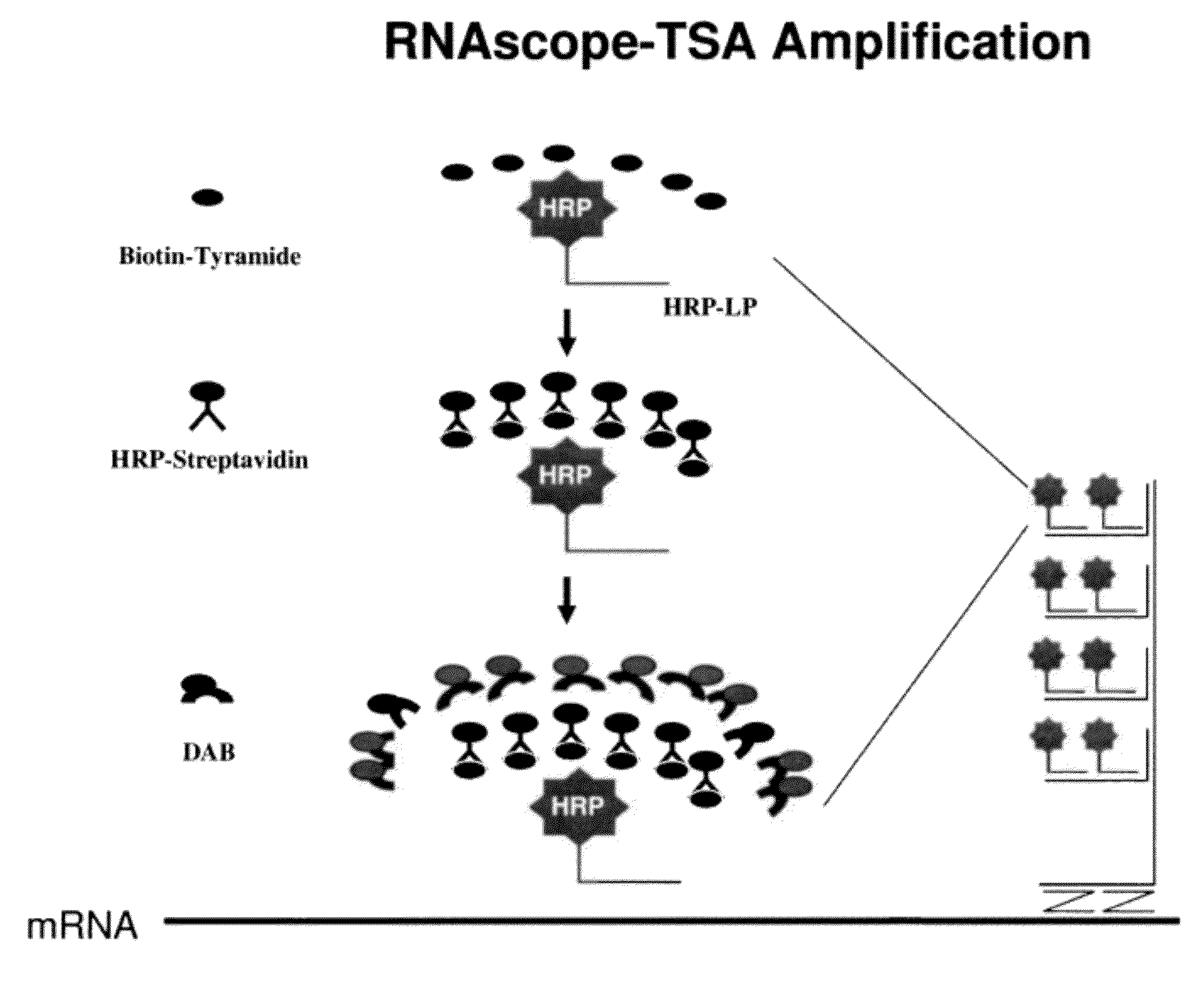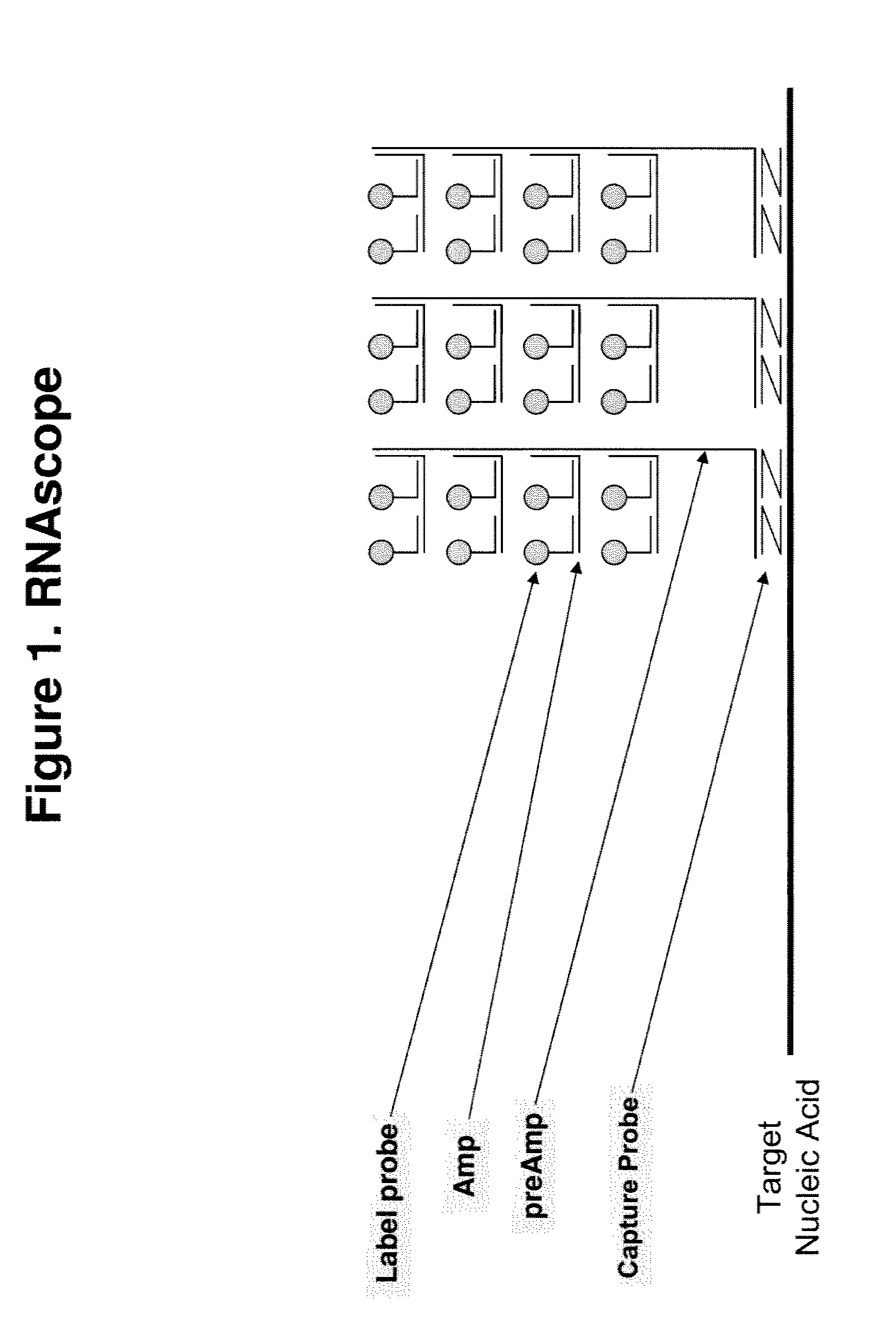Ultra sensitive method for in situ detection of nucleic acids
a nucleic acid and in situ detection technology, applied in the field of nucleic acid chemistry and biochemical assays, can solve the problems of poor access to the target sequence of the detection probe, difficult application of ish techniques in clinical settings, and inability to detect nucleic acids in situ, etc., to achieve high detection accuracy, low background, and high specificity.
- Summary
- Abstract
- Description
- Claims
- Application Information
AI Technical Summary
Benefits of technology
Problems solved by technology
Method used
Image
Examples
example 1
RNAscope®+General ISH Signal Amplification Assay
[0093]The basic assay procedure can be done within a day and generally includes the following steps. A sample containing a plurality of cells suspected of comprising a target nucleic acid HPRT1 is provided. After being fixed and permeabilized, cells either fixed on a solid support or in suspension are hybridized to the following series of oligonucleotide probes. First, a set of capture probes is hybridized to the target RNA inside the cells. Next, preamplifier molecules are hybridized to the capture probes, providing a bridge for the hybridization of amplifier molecules. Multiple amplifier molecules are further hybridized to a preamplifier, e.g., up to 20 amplifiers to each preamplifier. Multiple label probes are then hybridized to an amplifier, e.g. up to 20 label probes to each amplifier.
[0094]The signal intensity is enhanced further by TSA-based ISH signal amplification. An HRP is conjugated to each label probe. Reagent containing t...
example 2
Multiplex RNAscope®+General ISH Signal Amplification Assay
[0099]The following prophetic example of a multiplexed amplification showing how the method disclosed in the present invention can detect two target nucleic acids with high sensitivity. To explore the potential of the disclosed invention for in situ detection of low copy RNA transcripts and its capability for multiplex detection, 18S and Her-2 are used as the model genes.
[0100]In the first amplification, 18S gene is captured on capture probes designed for 18S. The capture probe for 18S is designed as described in example 1. The capture-probe-hybridized-18S gene is then sequentially hybridized to preamplifiers, amplifiers and label probes. The label probe is then conjugated to HRP. The conjugated LP-HRP complexes are then detected with sequential incubations of tyramide-biotin, streptavidin-HRP and DAB. The product of the hybridization produces brown color at locations where target gene 18Ss are detected.
[0101]Before starting ...
PUM
| Property | Measurement | Unit |
|---|---|---|
| Fluorescent in situ hybridization | aaaaa | aaaaa |
| tissue morphology | aaaaa | aaaaa |
| molecular structure | aaaaa | aaaaa |
Abstract
Description
Claims
Application Information
 Login to View More
Login to View More - R&D
- Intellectual Property
- Life Sciences
- Materials
- Tech Scout
- Unparalleled Data Quality
- Higher Quality Content
- 60% Fewer Hallucinations
Browse by: Latest US Patents, China's latest patents, Technical Efficacy Thesaurus, Application Domain, Technology Topic, Popular Technical Reports.
© 2025 PatSnap. All rights reserved.Legal|Privacy policy|Modern Slavery Act Transparency Statement|Sitemap|About US| Contact US: help@patsnap.com



